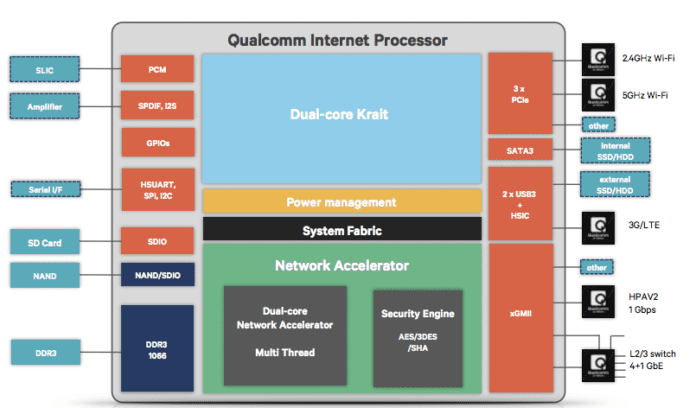Carriers are sure to hear a lot about Qualcomm’s newest mobile processor in the months ahead, but the chip giant is also eager to focus carrier attention on its new line of Internet processors. “I spend a lot of time answering the question ‘What is an Internet processor and why are you making one?'” said Qualcomm Atheros vice president Todd Antes.
Antes answers that question by first explaining that Qualcomm’s Internet processor chipset combines a network processor and an applications processor, pairing a dual-core Krait applications processor with a new packet processor engine to create two new chipsets: the IPQ 8064 and the lower performance IPQ 8062. Both solutions are smaller than the face of a quarter.
Qualcomm created the IPQ family in an effort to secure its place in the devices that will enable the connected home. Antes sees two initial target markets: service provider gateways and broadband home routers.
“We see a tremendous opportunity for creating another platform, particularly in the home,” said Antes. “Today we know that service providers are making a good business with their IP-based triple play services. But one of the things that they are very interested in [is]…. What other additional services can they provide? Whether they be revenue-grade services that increase their revenue per user or whether they be things that simply augment your existing services that they provide you at no charge, that makes you a more loyal customer.”
“To enable that type of expandable applications platform we need not just the network processor but an applications processor counterpoint that can run a high level OS [Linux],” Antes continued. “In our case we’re borrowing an applications processor right out of our mobile chipset roadmap.” That roadmap got an update today with Qualcomm’s announcement of its newest mobile processor, the Snapdragon 805.)
Power efficiency was a key focus for Qualcomm in developing the IPQ family. “We do start to see legislation and rules being written that actually set limits on the power that can be consumed by home networking gear,” said Antes. Even if consumers are not completely aware of how much power their home routers are consuming, enterprise customers will be watching this, and the enterprise is the next target for Qualcomm’s IPQ product line.
“In 2014, [we expect] new devices in the [IPQ] family for enterprise and SMB markets, access points as well for public area hotspots and infrastructure devices,” said Antes. “The bigger pictures goes after a range of devices at the edge of the network.”
Follow me on Twitter.

